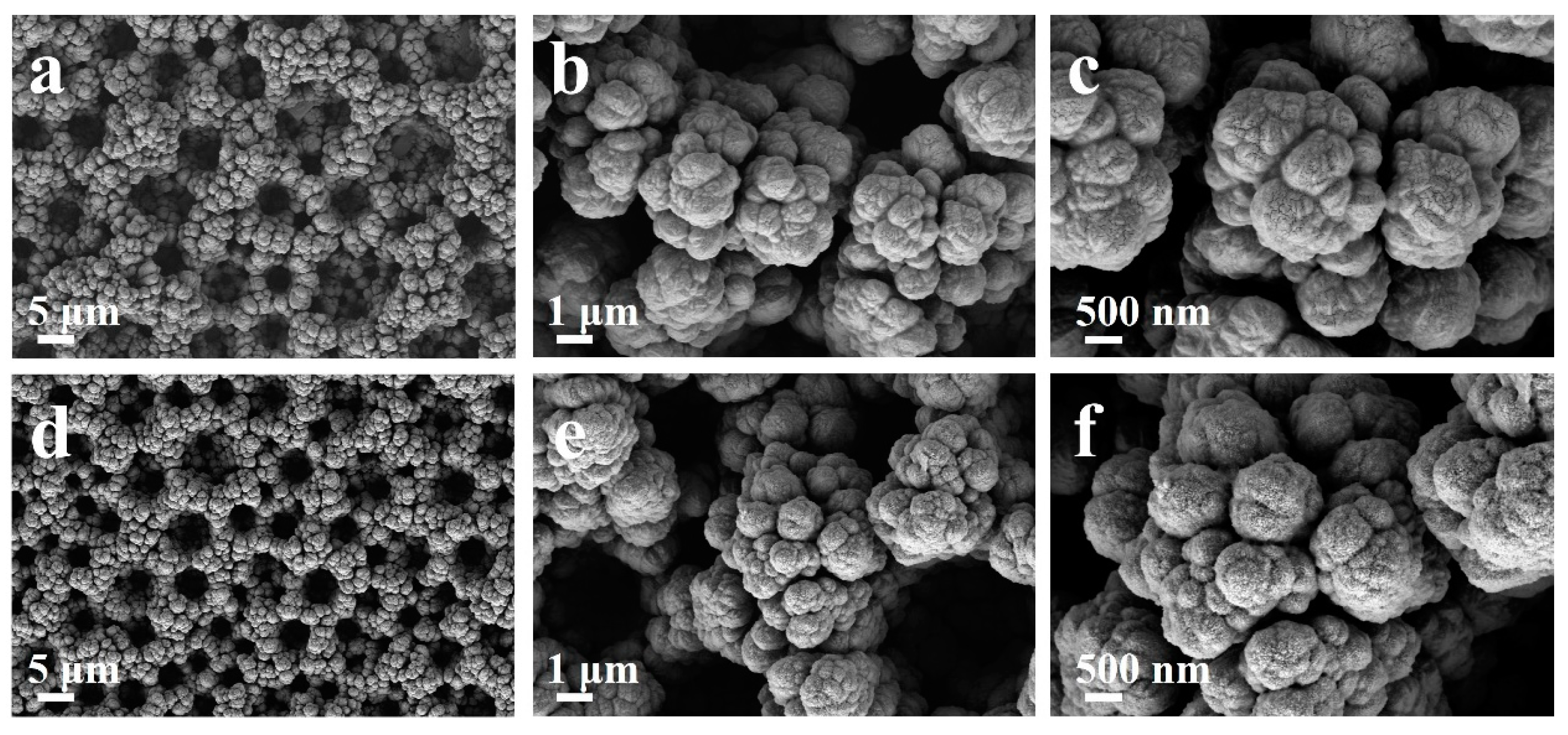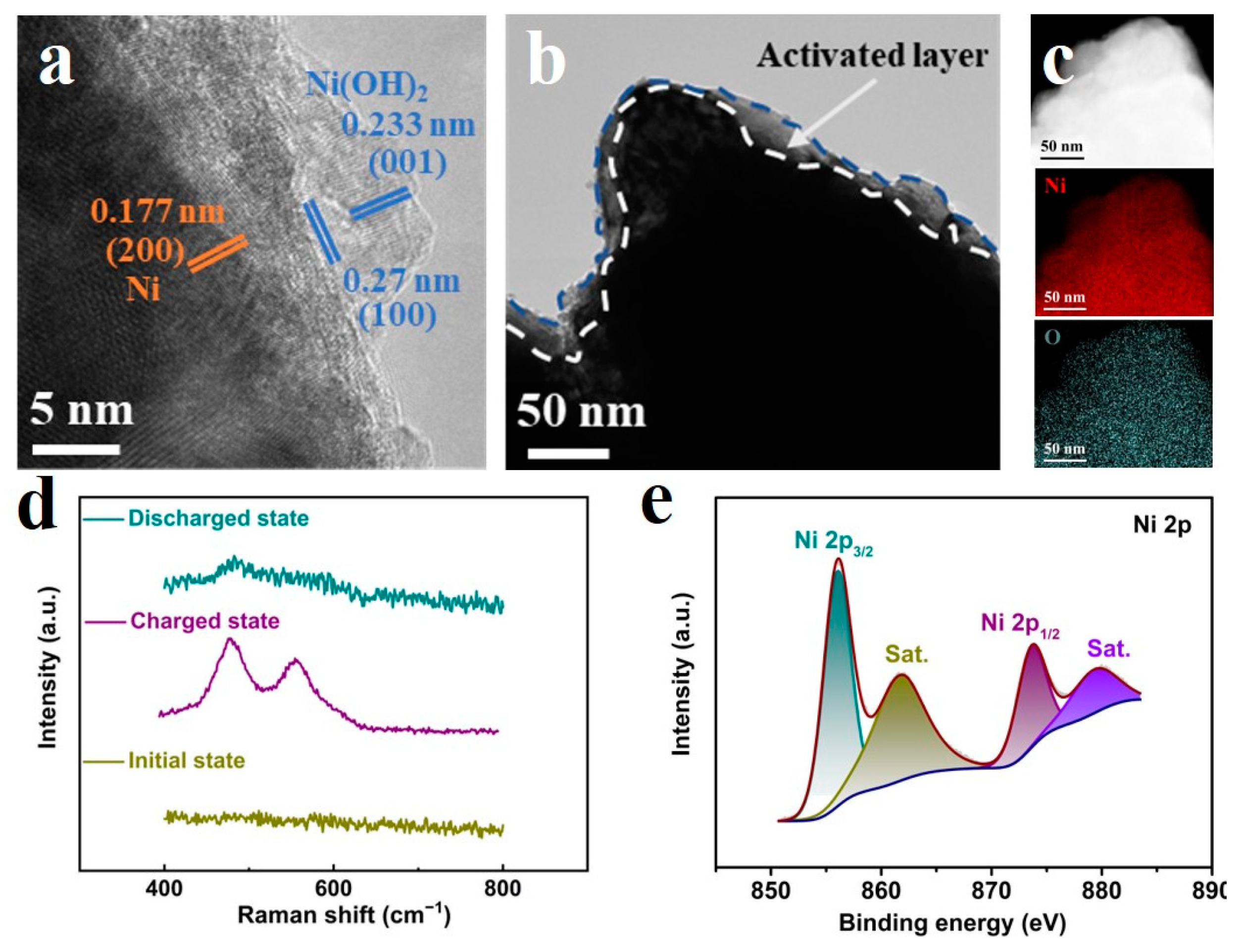Alkaline Ni-Zn Microbattery Based on 3D Hierarchical Porous Ni Microcathode with High-Rate Performance
Abstract
1. Introduction
2. Materials and Methods
2.1. Preparation of an Activated 3D Hierarchical Porous Ni Microcathode
2.2. Preparation of Zinc Microanode
2.3. Assembly of Ni-Zn MB
2.4. Characterizations of Structure and Composition
2.5. Electrochemical Measurements
3. Results and Discussion
4. Conclusions
Supplementary Materials
Author Contributions
Funding
Conflicts of Interest
References
- Lethien, C.; Le Bideau, J.; Brousse, T. Challenges and prospects of 3D micro-supercapacitors for powering the internet of things. Energy Environ. Sci. 2019, 12, 96–115. [Google Scholar] [CrossRef]
- Hur, J.I.; Smith, L.C.; Dunn, B. High areal energy density 3D lithium-ion microbatteries. Joule 2018, 2, 1187–1201. [Google Scholar] [CrossRef]
- Lai, W.; Wang, Y.; Lei, Z.; Wang, R.; Lin, Z.; Wong, C.-P.; Kang, F.; Yang, C. High performance, environmentally benign and integratable Zn//MnO2 microbatteries. J. Mater. Chem. A 2018, 6, 3933–3940. [Google Scholar] [CrossRef]
- Ma, X.; Hong, X.; He, L.; Xu, L.; Zhang, Y.; Zhu, Z.; Pan, X.; Zhu, J.; Mai, L. High energy density micro-supercapacitor based on a three-dimensional bicontinuous porous carbon with interconnected hierarchical pores. ACS Appl. Mater. Inter. 2018, 11, 948–956. [Google Scholar] [CrossRef]
- Jin, X.; Song, L.; Dai, C.; Xiao, Y.; Han, Y.; Li, X.; Wang, Y.; Zhang, J.; Zhao, Y.; Zhang, Z. A Flexible Aqueous Zinc-Iodine Microbattery with Unprecedented Energy Density. Adv. Mater. 2022, 34, 2109450. [Google Scholar] [CrossRef]
- Qi, D.; Liu, Y.; Liu, Z.; Zhang, L.; Chen, X. Design of architectures and materials in in-plane micro-supercapacitors: Current status and future challenges. Adv. Mater. 2017, 29, 1602802. [Google Scholar] [CrossRef] [PubMed]
- Wang, X.; Wang, F.; Wang, L.; Li, M.; Wang, Y.; Chen, B.; Zhu, Y.; Fu, L.; Zha, L.; Zhang, L. An aqueous rechargeable Zn//Co3O4 battery with high energy density and good cycling behavior. Adv. Mater. 2016, 28, 4904–4911. [Google Scholar] [CrossRef]
- Xu, L.; Tang, S.; Cheng, Y.; Wang, K.; Liang, J.; Liu, C.; Cao, Y.-C.; Wei, F.; Mai, L. Interfaces in solid-state lithium batteries. Joule 2018, 2, 1991–2015. [Google Scholar] [CrossRef]
- Qu, Z.; Zhu, M.; Yin, Y.; Huang, Y.; Tang, H.; Ge, J.; Li, Y.; Karnaushenko, D.D.; Karnaushenko, D.; Schmidt, O.G. A Sub-Square-Millimeter Microbattery with Milliampere-Hour-Level Footprint Capacity. Adv. Energy Mater. 2022, 12, 2200714. [Google Scholar] [CrossRef]
- Li, Y.; Zhu, M.; Bandari, V.K.; Karnaushenko, D.D.; Karnaushenko, D.; Zhu, F.; Schmidt, O.G. On-Chip Batteries for Dust-Sized Computers. Adv. Energy Mater. 2022, 12, 2103641. [Google Scholar] [CrossRef]
- Li, Y.; Zhu, M.; Karnaushenko, D.D.; Li, F.; Qu, J.; Wang, J.; Zhang, P.; Liu, L.; Ravishankar, R.; Bandari, V.K.; et al. Microbatteries with twin-Swiss-rolls redefine performance limits in the sub-square millimeter range. Nanoscale Horiz. 2023, 8, 127–132. [Google Scholar] [CrossRef] [PubMed]
- Ma, J.; Quhe, R.; Zhang, W.; Yan, Y.; Tang, H.; Qu, Z.; Cheng, Y.; Schmidt, O.G.; Zhu, M. Zn Microbatteries Explore Ways for Integrations in Intelligent Systems. Small 2023, 2300230. [Google Scholar] [CrossRef] [PubMed]
- Li, M.; Meng, J.; Li, Q.; Huang, M.; Liu, X.; Owusu, K.A.; Liu, Z.; Mai, L. Finely Crafted 3D Electrodes for Dendrite-Free and High-Performance Flexible Fiber-Shaped Zn-Co Batteries. Adv. Funct. Mater. 2018, 28, 1802016. [Google Scholar] [CrossRef]
- Yang, Q.; Liang, G.; Guo, Y.; Liu, Z.; Yan, B.; Wang, D.; Huang, Z.; Li, X.; Fan, J.; Zhi, C. Do zinc dendrites exist in neutral zinc batteries: A developed electrohealing strategy to in situ rescue in-service batteries. Adv. Mater. 2019, 31, 1903778. [Google Scholar] [CrossRef]
- Wang, Y.; Hong, X.; Guo, Y.; Zhao, Y.; Liao, X.; Liu, X.; Li, Q.; He, L.; Mai, L. Wearable Textile-Based Co-Zn Alkaline Micro battery with High Energy Density and Excellent Reliability. Small 2020, 16, 2000293. [Google Scholar] [CrossRef]
- Tian, Z.; Sun, Z.; Shao, Y.; Gao, L.; Huang, R.; Shao, Y.; Kaner, R.B.; Sun, J. Ultrafast rechargeable Zn micro-batteries endowing a wearable solar charging system with high overall efficiency. Energy Environ. Sci. 2021, 14, 1602–1611. [Google Scholar] [CrossRef]
- Chen, Q.; Li, J.; Liao, C.; Hu, G.; Fu, Y.; Asare, O.K.; Shi, S.; Liu, Z.; Zhou, L.; Mai, L. Ni foam supported NiO nanosheets as high-performance free-standing electrodes for hybrid supercapacitors and Ni-Zn batteries. J. Mater. Chem. A 2018, 6, 19488–19494. [Google Scholar] [CrossRef]
- Wang, R.; Han, Y.; Wang, Z.; Jiang, J.; Tong, Y.; Lu, X. Nickel@ nickel oxide core-shell electrode with significantly boosted reactivity for ultrahigh-energy and stable aqueous Ni-Zn battery. Adv. Funct. Mater. 2018, 28, 1802157. [Google Scholar] [CrossRef]
- Zheng, S.; Huang, H.; Dong, Y.; Wang, S.; Zhou, F.; Qin, J.; Sun, C.; Yu, Y.; Wu, Z.-S.; Bao, X. Ionogel-based sodium ion micro-batteries with a 3D Na-ion diffusion mechanism enable ultrahigh rate capability. Energy Environ. Sci. 2020, 13, 821–829. [Google Scholar] [CrossRef]
- Zhou, G.; Xu, L.; Hu, G.; Mai, L.; Cui, Y. Nanowires for electrochemical energy storage. Chem. Rev. 2019, 119, 11042–11109. [Google Scholar] [CrossRef]
- Cao, D.; Xing, Y.; Tantratian, K.; Wang, X.; Ma, Y.; Mukhopadhyay, A.; Cheng, Z.; Zhang, Q.; Jiao, Y.; Chen, L. 3D printed high-performance lithium metal microbatteries enabled by nanocellulose. Adv. Mater. 2019, 31, 1807313. [Google Scholar] [CrossRef] [PubMed]
- Sun, P.; Li, X.; Shao, J.; Braun, P.V. High-performance packaged 3D lithium-ion microbatteries fabricated using imprint lithography. Adv. Mater. 2021, 33, 2006229. [Google Scholar] [CrossRef] [PubMed]
- Hao, Z.; Xu, L.; Liu, Q.; Yang, W.; Liao, X.; Meng, J.; Hong, X.; He, L.; Mai, L. On-chip Ni-Zn microbattery based on hierarchical ordered porous Ni@Ni(OH)2 microelectrode with ultrafast ion and electron transport kinetics. Adv. Funct. Mater. 2019, 29, 1808470. [Google Scholar] [CrossRef]
- Zhu, Z.; Kan, R.; Hu, S.; He, L.; Hong, X.; Tang, H.; Luo, W. Recent Advances in High-Performance Microbatteries: Construction, Application, and Perspective. Small 2020, 16, 2003251. [Google Scholar] [CrossRef] [PubMed]
- Ma, J.; Zheng, S.; Chi, L.; Liu, Y.; Zhang, Y.; Wang, K.; Wu, Z.S. 3D Printing Flexible Sodium-Ion Microbatteries with Ultrahigh Areal Capacity and Robust Rate Capability. Adv. Mater. 2022, 34, 2205569. [Google Scholar] [CrossRef] [PubMed]
- Zhu, Z.; Kan, R.; Wu, P.; Ma, Y.; Wang, Z.; Yu, R.; Liao, X.; Wu, J.; He, L.; Hu, S. A Durable Ni-Zn Microbattery with Ultrahigh-Rate Capability Enabled by In Situ Reconstructed Nanoporous Nickel with Epitaxial Phase. Small 2021, 17, 2103136. [Google Scholar] [CrossRef]
- Liu, X.; Ni, K.; Wen, B.; Guo, R.; Niu, C.; Meng, J.; Li, Q.; Wu, P.; Zhu, Y.; Wu, X. Deep reconstruction of nickel-based precata- lysts for water oxidation catalysis. ACS Energy Lett. 2019, 4, 2585–2592. [Google Scholar] [CrossRef]
- Liu, X.; Meng, J.; Zhu, J.; Huang, M.; Wen, B.; Guo, R.; Mai, L. Comprehensive understandings into complete reconstruction of precatalysts: Synthesis, applications, and characterizations. Adv. Mater. 2021, 33, 2007344. [Google Scholar] [CrossRef]
- Lim, M.B.; Lambert, T.N.; Ruiz, E.I. Effect of ZnO-Saturated Electrolyte on Rechargeable Alkaline Zinc Batteries at Increased Depth-of-Discharge. J. Electrochem. Soc. 2020, 167, 060508. [Google Scholar] [CrossRef]
- Huang, J.; Li, Y.; Zhang, Y.; Rao, G.; Wu, C.; Hu, Y.; Wang, X.; Lu, R.; Li, Y.; Xiong, J. Identification of key reversible intermediates in self-reconstructed nickel-based hybrid electrocatalysts for oxygen evolution. Angew. Chem. 2019, 131, 17619–17625. [Google Scholar] [CrossRef]
- Chen, Z.; Cai, L.; Yang, X.; Kronawitter, C.; Guo, L.; Shen, S.; Koel, B.E. Reversible structural evolution of NiCoOxHy during the oxygen evolution reaction and identification of the catalytically active phase. ACS Catal. 2018, 8, 1238–1247. [Google Scholar] [CrossRef]
- Lo, Y.L.; Hwang, B.J. In situ Raman studies on cathodically deposited nickel hydroxide films and electroless Ni-P electrodes in 1 M KOH solution. Langmuir 1998, 14, 944–950. [Google Scholar] [CrossRef]
- He, W.; Wang, S.; Shao, Y.; Kong, Z.; Tu, H.; Wu, Y.; Hao, X. Water invoking interface corrosion: An energy density booster for Ni//Zn battery. Adv. Energy Mater. 2021, 11, 2003268. [Google Scholar] [CrossRef]
- Zhou, W.; Zhu, D.; He, J.; Li, J.; Chen, H.; Chen, Y.; Chao, D. A scalable top-down strategy toward practical metrics of Ni-Zn aqueous batteries with total energy densities of 165 W h kg−1 and 506 W h L−1. Energy Environ. Sci. 2020, 13, 4157–4167. [Google Scholar] [CrossRef]
- Zhang, H.; Zhou, Y.; Xu, M.; Chen, A.; Ni, Z.; Akdim, O.; Wågberg, T.; Huang, X.; Hu, G. Interface Engineering on Amorphous/Crystalline Hydroxides/Sulfides Heterostructure Nanoarrays for Enhanced Solar Water Splitting. ACS Nano 2022, 17, 636–647. [Google Scholar] [CrossRef]
- Li, L.; Cheng, S.; Deng, L.; Liu, T.; Dong, W.; Liu, Y.; Huang, L.; Yao, H.; Ji, X. Effective Solution toward the Issues of Zn-Based Anodes for Advanced Alkaline Ni-Zn Batteries. ACS Appl. Mater. Inter. 2023, 15, 3953–3960. [Google Scholar] [CrossRef]




Disclaimer/Publisher’s Note: The statements, opinions and data contained in all publications are solely those of the individual author(s) and contributor(s) and not of MDPI and/or the editor(s). MDPI and/or the editor(s) disclaim responsibility for any injury to people or property resulting from any ideas, methods, instructions or products referred to in the content. |
© 2023 by the authors. Licensee MDPI, Basel, Switzerland. This article is an open access article distributed under the terms and conditions of the Creative Commons Attribution (CC BY) license (https://creativecommons.org/licenses/by/4.0/).
Share and Cite
You, G.; Zhu, Z.; Duan, Y.; Lv, L.; Liao, X.; He, X.; Yang, K.; Song, R.; Yang, Y.; He, L. Alkaline Ni-Zn Microbattery Based on 3D Hierarchical Porous Ni Microcathode with High-Rate Performance. Micromachines 2023, 14, 927. https://doi.org/10.3390/mi14050927
You G, Zhu Z, Duan Y, Lv L, Liao X, He X, Yang K, Song R, Yang Y, He L. Alkaline Ni-Zn Microbattery Based on 3D Hierarchical Porous Ni Microcathode with High-Rate Performance. Micromachines. 2023; 14(5):927. https://doi.org/10.3390/mi14050927
Chicago/Turabian StyleYou, Gongchuan, Zhe Zhu, Yixue Duan, Linfeng Lv, Xiaoqiao Liao, Xin He, Kai Yang, Ruiqi Song, Yi Yang, and Liang He. 2023. "Alkaline Ni-Zn Microbattery Based on 3D Hierarchical Porous Ni Microcathode with High-Rate Performance" Micromachines 14, no. 5: 927. https://doi.org/10.3390/mi14050927
APA StyleYou, G., Zhu, Z., Duan, Y., Lv, L., Liao, X., He, X., Yang, K., Song, R., Yang, Y., & He, L. (2023). Alkaline Ni-Zn Microbattery Based on 3D Hierarchical Porous Ni Microcathode with High-Rate Performance. Micromachines, 14(5), 927. https://doi.org/10.3390/mi14050927






